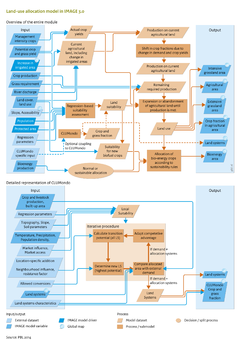Land-use allocation/Description: Difference between revisions
Jump to navigation
Jump to search
No edit summary |
No edit summary |
||
| Line 9: | Line 9: | ||
Crop and grassland is either abandoned or expanded until the required production is met. Since actual yields are taken into account, changes in crop yields in time due to technological change, climate change and land heterogeneity are included. If yields in the new agricultural areas are lower than average in the current area, relatively more agricultural land is required compared to the production increase. | Crop and grassland is either abandoned or expanded until the required production is met. Since actual yields are taken into account, changes in crop yields in time due to technological change, climate change and land heterogeneity are included. If yields in the new agricultural areas are lower than average in the current area, relatively more agricultural land is required compared to the production increase. | ||
In determining the location of agricultural expansion or abandonment, all grid cells are assessed and ranked on suitability, based on an empirical regression analysis, and optionally based on a link to CLUMondo (see further below). | In determining the location of agricultural expansion or abandonment, all grid cells are assessed and ranked on suitability, based on an empirical regression analysis, and optionally based on a link to [[CLUMondo model|CLUMondo]] (see further below). | ||
Additionally, a few other rules are applied in determining the location of new agricultural land. For instance, agricultural expansion is not permitted in protected areas, and in areas otherwise protected, such as in assumed REDD (reducing emissions from deforestation and degradation) schemes. A grid cell is only regarded suitable for agriculture if the potential rain-fed production is at least 5% of the global maximum attainable crop yield. Grid cells with a production potential between 0.05 and 5% of the maximum attainable are still assumed suitable for extensive grassland. | Additionally, a few other rules are applied in determining the location of new agricultural land. For instance, agricultural expansion is not permitted in protected areas, and in areas otherwise protected, such as in assumed {{abbrTemplate|REDD}} (reducing emissions from deforestation and degradation) schemes. A grid cell is only regarded suitable for agriculture if the potential rain-fed production is at least 5% of the global maximum attainable crop yield. Grid cells with a production potential between 0.05 and 5% of the maximum attainable are still assumed suitable for extensive grassland. | ||
Irrigated areas are increased on a regional scale, prescribed by external scenario dependent assumptions, such as based on FAO ([[Alexandratos and Bruinsma, 2012]]). In each time-step, more irrigated areas are allocated in agricultural land based on the need for irrigation (the difference in rain-fed and irrigated yields), and water availability. | Irrigated areas are increased on a regional scale, prescribed by external scenario dependent assumptions, such as based on FAO ([[Alexandratos and Bruinsma, 2012]]). In each time-step, more irrigated areas are allocated in agricultural land based on the need for irrigation (the difference in rain-fed and irrigated yields), and water availability. | ||
Revision as of 14:25, 21 May 2014
Parts of Land-use allocation/Description
| Component is implemented in: |
| Components: |
| Related IMAGE components |
| Projects/Applications |
| Key publications |
| References |
